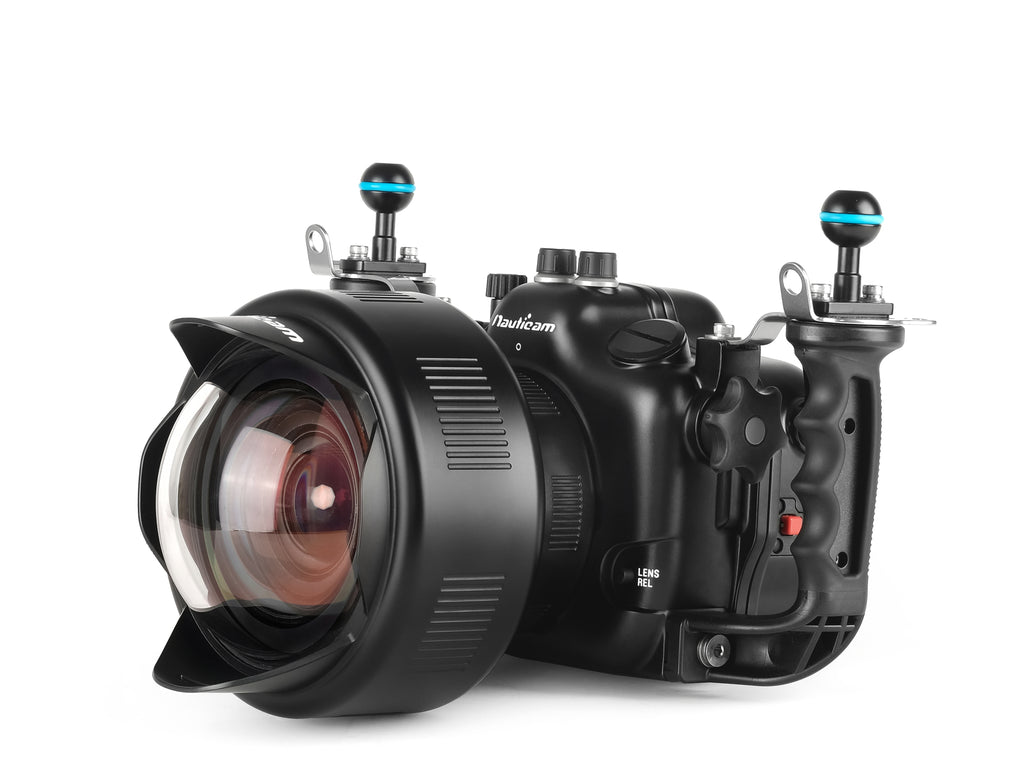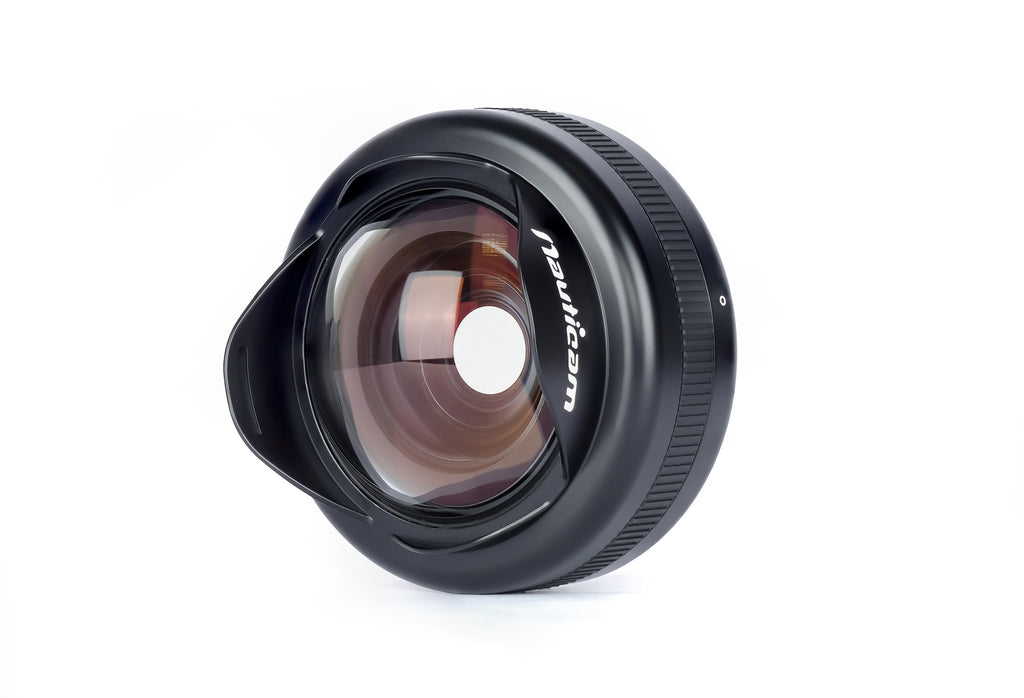Last year I decided to go big - switching from the tiny RX100 to FF (FullFormat). In my case, it was the A7IV as the best value for money. But having made the decision on the camera model is only one step - lens, housing and port is much more difficult. But with the support of the nice guys here and the old forum, I am now the happy owner of a sleek combination that is tailored to my needs. But how do you know what you need? This article might help.
The most common type of camera used by underwater photographers is one that is inserted with lens into a housing and has either a flat (flat port) or curved (dome port) front glass at the port.
Even in the days of analogue photography with the Nikonos system, for example, water contact lenses were developed that explicitly take into account the refraction of light at the water-to-glass contact surface. This reduces distortions that would otherwise occur when light hits the port at an angle and cause blurring at the edges.
Nauticam has therefore developed some different types of water contact optics that evolved and serve different purposes.
FCP (Fisheye Conversion Port) and WACP (Wide Angle Conversion Port) are "dry" optics designed to turn a mid-range zoom lens on the camera into a wide-angle zoom when the combination is taken under the surface. WWL (Wet Wide Lens) is the older version, somewhat less compact and made of more components, wet lens, but otherwise very similar to WACP.
EMWL (Extended Macro Wide Lens) takes a different approach: different underwater lenses are placed in front of a macro lens and a flat port in order to be able to adjust on different subjects - from macro to large fish.
First and newest: FCP
![]()
Picture courtesly provided by Alex Mustard
A dry lens that is attached directly to the housing with the appropriate (depending on the camera and lens) port extensions.
In concrete terms, you can imagine the FCP as an ultra-wide-angle lens for underwater use. A lens such as the Sony 28-60, Canon 24-50 or Nikon 24-50 is attached to the camera and the FCP is mounted on the housing. This achieves a maximum field of view of 175° - a real fisheye. In the zoom position, the field of view is still 85°, i.e. still quite wide-angle, comparable to a 24mm lens over water.
Next WACP: Still new, especially the WACP-C

The WACP ports with the endings -C for compact, -1 for the "normal" variant and -2 for the maximum variant are not quite as extreme. Also "dry" optics - see above. They are intended to cover a field of view of approx. 70°-130° - i.e. comparable to a lens with a normal focal length (approx. 30mm) to a slight fisheye wide angle (11mm). On the camera, the WACP-C and WACP-1 require similar lenses as for the FCP (for example Sony 28-60, Canon 24-50 or Nikon 24-50), but the largest variant requires a wider-angle lens such as 14-30mm to achieve the same field of view. These water contact lenses are quite bulky and heavy (WACP-C: 2.3kg, WACP-1: 3.9kg, WACP-2: 7.0kg) and offer better sharpness than dome ports, especially at the edges, but above all they provide a wide zoom range under water and focus even directly at the glass. The WACP-C, although labelled as a compact version, also fits some of the full-frame cameras and is the most suitable solution for me personally.
WWL-1(B):

AFAIK the two WWL ports (WWL-1 and the newer WWL-1B) are the predecessors of the WACP ports. The area of use is the same as with WACP: field of view approx. 70-130°, i.e. wide normal focal length to slightly ultra-wide angle/fisheye when using zoom lenses with a focal length range of approx. 25-60mm. The difference to the WACP solutions is the technical design. With WWL, you have a compact plan port on the housing and the WWL is mounted wet, i.e. with water between the front glass of the port and the WWL lens. Advantage over the WACP solutions: lighter overall, and you can remove the WWL under water and then have a lightweight telephoto lens (...no one ever does...). Disadvantage: The telephoto lens is rarely needed and air bubbles between the port and the WWL can be annoying.
EMWL: One size matters fits all

The EMWL wants to be and can be an "all in one":
The basic here is that an 90 mm macro lens is mounted on the camera and the corresponding port with flat glass at the front (flat port) is mounted on the underwater housing. A close-up lens (e.g. SMC-1) for magnification or the EMWL can be used on a flip port.
The EMWL consists of two or three elements:
- The focusing unit, which is available in variants for Nikon, Canon and Sony, is located directly in front of the macro port
- An optional extension piece (relay lens) then follows, which turns the image upside down and brings the front glass closer to the subject
- The actual lens, which is available in 160°, 130°, 100° and 60° angle of view versions, is located at the top. The 130° lens is particularly popular and is ideal for CFWA, but also for large fish or panoramic images.
In contrast to FCP and WACP, the EMWL is a wet lens, so there is water between the port glass and the focussing unit, but also between the relay lens and the objective lens. Image quality is high in every direction but bubbles between the parts can be annoying and there have been issues about focus breathing.
The main areas of application are thus:
FCP: Fisheye wide-angle zoom, medium volume, compact
WACP: Wide-angle zoom, medium to large volume depending on version
WWL: Comparable to WACP, Lighter and slightly cheaper, but with technical disadvantages
EMWL: fixed focal lengths that can be changed under water, somehow bulky, objectionable appearance
To show the differences in size and appearance here a pic from Alex Mustard, showing (left to right) FCP (prototype), WACP-C, WACP-2, WACP-1 (Thanks, Alex!)
![]()
Cost (€)? You have already camera, housing and lens. And focus gear. And port extension. And arms, flashes and so on. Just the port:
Rough estimates
FCP: EDIT Jan 14th: Now on Nauticam website €6.482,00 (incl. VAT)
WACP-C: €2.9k
WACP-1: €4.5k
WACP-2: €8.2k
WWL-1b: €1.9k (with flatport)
EMWL: €8.5k (with flatport, 60°, 100°, 130° optics, rely, focusing unit, flip-holder, SMC-1)
If I made errors or incorrectness anybody please feel free to add or correct




Recommended Comments